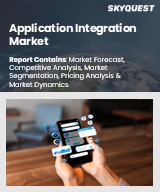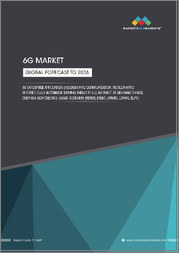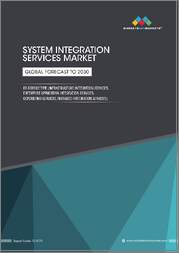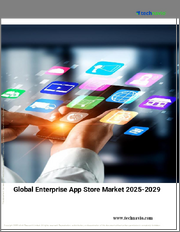
|
시장보고서
상품코드
1831830
기업 애플리케이션 시장 보고서 : 솔루션별, 조직 규모별, 배포 형태별, 최종사용자별, 지역별(2025-2033년)Enterprise Application Market Report by Solution, Organization Size, Deployment Mode, End User, and Region 2025-2033 |
||||||
세계의 기업 애플리케이션 시장 규모는 2024년에 3,149억 달러에 달했습니다. 향후 IMARC Group은 이 시장이 2033년까지 5,712억 달러에 달하며, 2025-2033년에 6.5%의 성장률(CAGR)을 보일 것으로 예측하고 있습니다. 이 시장은 주로 디지털 전환, AI 통합, 클라우드 배포에 대한 수요 증가로 인해 크게 성장하고 있습니다. 현재 북미가 가장 큰 시장 점유율을 차지하고 있으며, 이는 첨단 기술 인프라, 기업 솔루션에 대한 막대한 투자, 산업 전반에 걸쳐 혁신과 비즈니스 성장을 가속하는 정부 지원책에 힘입은 바 큽니다.
기업 용도에는 디지털 컨텐츠 제작, 커뮤니케이션 협업 소프트웨어, 고객 관계 관리(CRM), 기업 자원 계획(ERP) 등이 포함됩니다. 이들은 확장 가능하고, 컴포넌트 기반이며, 데이터 중심적이고, 사용자 친화적입니다. 영업, 재무, 회계, 재고, 인사, 제조 등 핵심 비즈니스 프로세스를 단일 서버 아키텍처에서 실시간으로 통합하는 데 사용됩니다. 오피스 스위트, 프로젝트 포트폴리오 관리, 공급망 관리(SCM)의 이점을 제공합니다. 그 결과, 대량의 복잡한 데이터를 다루는 비즈니스 프로세스를 자동화하고 전 세계 공급업체, 상업 단체, 고객 및 기업을 연결하기 위해 기업 네트워크에 도입되고 있습니다.
기업 용도 시장 동향 :
클라우드 배포 증가
클라우드의 도입은 탁월한 유연성과 확장성을 제공함으로써 기업 용도의 상황을 완전히 바꾸고 있습니다. 수요에 따라 리소스를 쉽게 조정할 수 있는 클라우드 기반 솔루션으로 전환하는 기업이 증가하고 있으며, IT 인프라에 대한 고가의 선행 투자가 필요하지 않아 비용 효율성을 확보할 수 있습니다. 예를 들어 인포시스는 2024년 7월 유럽의 대형 보안 업체인 섹터 알람(Sector Alarm)과 기업용 업무 시스템을 클라우드로 전환하기 위한 5년간의 협업을 발표했습니다. 인포시스는 Sector Alarm과 긴밀히 협력하여 On-Premise Enterprise Resource Planning 플랫폼을 Microsoft Dynamics 365 Finance and Operations로 마이그레이션합니다. 이러한 전환은 유지보수 및 운영 비용을 절감할 뿐만 아니라 민첩성을 높여 기업이 시장 변화에 빠르게 대응할 수 있도록 돕습니다. 클라우드 플랫폼은 어디서든 용도에 원활하게 액세스할 수 있으며, 원격 근무를 지원하고 분산된 팀 간의 협업을 촉진합니다. 기업 용도 시장 예측에 따르면 기업이 디지털 혁신과 탄력적인 인프라를 계속 우선순위에 두고 있는 가운데, 클라우드 배포는 앞으로도 시장 발전를 촉진하는 매우 중요한 요소로 작용할 것으로 보입니다. 또한 자동 업데이트, 강력한 보안 조치, 첨단 통합 기능 등의 기능으로 인해 클라우드 기반 용도는 혁신과 경쟁력을 유지하고자 하는 기업에게 선호되는 선택이 되고 있습니다.
AI와 자동화 통합
최신 기업 용도에 AI와 자동화를 통합하여 효율성과 의사결정을 강화함으로써 업무에 혁명을 일으킬 수 있습니다. 예측 분석, 자연 언어 처리(NLP), 머신러닝(ML) 등 AI 기반 기능을 통해 용도는 방대한 양의 데이터를 분석하고, 패턴을 식별하고, 실행 가능한 인사이트를 도출할 수 있습니다. 자동화를 통해 반복적인 작업의 효율성을 높이고, 인적 오류를 줄이고, 워크플로우를 가속화하여 직원들이 전략적 활동에 집중할 수 있도록 도와줍니다. 이러한 경쟁 환경은 큰 혁신의 원동력이 되어 기업은 생산성을 높이고, 고객 경험을 향상시키며, 빠르게 진화하는 디지털 환경에서 경쟁력을 유지할 수 있습니다. 예를 들어 2024년 3월 SAP와 엔비디아와는 기업용 클라우드 솔루션에 생성형 AI를 도입하고 기업 맞춤형 AI 기능을 제공하기 위한 제휴를 발표했습니다. 이번 제휴는 엔비디아와 SAP의 클라우드 솔루션과 용도에 생성형 AI를 통합하기 위해 엔비디아의 AI 주조 서비스와 마이크로서비스를 활용합니다. 이번 파트너십은 조직 전반에 걸쳐 AI 도입을 가속화하고 혁신적인 이용 사례를 통해 고객 인사이트를 강화하는 것을 목표로 하고 있습니다. 이러한 시너지 효과는 생산성과 업무 효율성을 높일 뿐만 아니라, 혁신과 민첩성을 촉진하여 빠르게 변화하는 시장에서 기업이 경쟁력을 유지할 수 있도록 돕습니다.
IoT 통합
IoT 통합은 귀중한 데이터를 생성하는 방대한 장치 네트워크를 연결하여 기업 용도에 혁명을 가져옵니다. 예를 들어 제조업의 경우, IoT 지원 시스템은 기계를 실시간으로 모니터링하고, 유지보수 필요성을 예측하여 다운타임을 줄입니다. 헬스케어 분야에서는 커넥티드 디바이스가 환자의 바이탈을 지속적으로 추적하여 환자 관리와 업무 효율성을 향상시킵니다. 물류 기업은 IoT 용도를 사용하여 배송을 모니터링하고, 경로를 최적화하고, 재고를 정확하게 관리하고 있습니다. 이러한 커넥티드 디바이스로부터 데이터를 수집하고 분석함으로써 기업은 실용적인 인사이트를 얻고, 정보에 입각한 의사결정을 내리고, 프로세스를 간소화할 수 있습니다. 예를 들어 Oracle은 2024년 8월 AT&T의 IoT 커넥티비티와 네트워크 API를 ECP(Enterprise Communications Platform)에 통합하여 안정적이고 안전한 통신을 제공합니다. 이 통합은 Oracle의 산업 클라우드 애플리케이션를 지원하며, AT&T 네트워크의 IoT 디바이스에 실시간 연결성을 제공합니다. 이 협력에는 Oracle의 Public Safety Suite의 기반이 되는 AT&T와 함께 구축한 FirstNet(R)도 포함되어 있으며, 출동지휘센터 및 구급대원을 위한 실시간 카메라 피드와 같은 중요한 구성 요소의 안전한 통신을 가능하게 합니다. 이러한 통합은 생산성을 향상시키고 비용을 절감할 뿐만 아니라 혁신을 촉진하여 기업이 다양한 산업 시장 변화와 고객의 요구에 신속하게 대응할 수 있도록 돕습니다. 이러한 기업 용도 시장 동향은 전 세계에서 시장 확대에 대한 긍정적인 전망을 낳고 있습니다.
이 보고서에서 다룬 주요 질문
- 세계 기업 용도 시장은 지금까지 어떻게 변화해왔고, 앞으로 어떻게 변화하는가?
- COVID-19가 세계 기업 용도 시장에 미치는 영향은?
- 주요 지역 시장은?
- 솔루션별 시장 현황은?
- 조직 규모별 시장 현황은?
- 전개 형태별 시장 분석은?
- 최종사용자별 시장 분석은?
- 산업 밸류체인의 다양한 단계는?
- 업계의 주요 촉진요인과 과제는?
- 세계 기업 용도 시장 구조와 주요 기업은?
- 업계내 경쟁은 어느 정도인가?
목차
제1장 서문
제2장 조사 범위와 조사 방법
- 조사의 목적
- 이해관계자
- 데이터 소스
- 1차 정보
- 2차 정보
- 시장 추정
- 보텀업 어프로치
- 톱다운 어프로치
- 조사 방법
제3장 개요
제4장 서론
제5장 세계의 기업 애플리케이션 시장
- 시장 개요
- 시장 실적
- COVID-19의 영향
- 시장 예측
제6장 시장 내역 : 솔루션
- 고객관계관리
- 전사적 자원 관리
- 공급망 관리
- 분석과 비즈니스 인텔리전스
- 인재 관리
- 생산성 툴
- 기타
제7장 시장 내역 : 조직 규모별
- 중소기업
- 대기업
제8장 시장 내역 : 배포 형태별
- 온프레미스
- 클라우드 기반
제9장 시장 내역 : 최종사용자별
- BFSI
- 제조업과 소매업
- 헬스케어와 의약품
- IT와 통신
- 정부
- 기타
제10장 시장 내역 : 지역별
- 북미
- 미국
- 캐나다
- 아시아태평양
- 중국
- 일본
- 인도
- 한국
- 호주
- 인도네시아
- 기타
- 유럽
- 독일
- 프랑스
- 영국
- 이탈리아
- 스페인
- 러시아
- 기타
- 라틴아메리카
- 브라질
- 멕시코
- 기타
- 중동 및 아프리카
제11장 SWOT 분석
제12장 밸류체인 분석
제13장 Porter's Five Forces 분석
제14장 가격 분석
제15장 경쟁 구도
- 시장 구조
- 주요 기업
- 주요 기업의 개요
- Accenture plc
- Fujitsu Limited
- Infosys Limited
- International Business Machines Corporation
- iTransition Group
- Microsoft Corporation
- Oracle Corporation
- Pegasystems Inc.
- Salesforce.com Inc.
- SAP SE
- Software AG
- Tata Consultancy Services Limited
The global enterprise application market size reached USD 314.9 Billion in 2024. Looking forward, IMARC Group expects the market to reach USD 571.2 Billion by 2033, exhibiting a growth rate (CAGR) of 6.5% during 2025-2033. The market is witnessing significant growth mainly driven by the increasing demand for digital transformation, AI integration, and cloud adoption. Currently, North America holds the largest market share, fueled by advanced technological infrastructure, substantial investments in enterprise solutions and supportive government initiatives promoting innovation and business growth across industries.
Enterprise applications include digital and content creation, communication and collaboration software, customer relationship management (CRM), and enterprise resource planning (ERP). They are scalable, component-based, data-centric, and user-friendly. They are used to integrate core business processes, such as sales, finance, accounting, inventory, human resources, and manufacturing, on a single server architecture in real-time. They provide the advantages of office suites, project and portfolio management, and supply chain management (SCM). Consequently, they are deployed in corporate networks to automate business processes with large amounts of complex data and connect enterprises with suppliers, commercial entities, and customers across the globe.
Enterprise Application Market Trends:
Increase in Cloud Adoption
Cloud adoption is transforming the enterprise application landscape by offering unmatched flexibility and scalability. Businesses are increasingly migrating to cloud-based solutions to easily adjust resources based on the demand, ensuring cost-efficiency by eliminating the need for hefty upfront investments in IT infrastructure. For instance, in July 2024, Infosys announced a five-year collaboration with Sector Alarm, a leading security provider in Europe, to migrate their enterprise business systems to the cloud. Infosys will work closely with Sector Alarm to move their on-premises Enterprise Resource Planning platform to Microsoft Dynamics 365 Finance and Operations. This shift not only reduces maintenance and operational costs but also enhances agility, allowing organizations to quickly respond to market changes. Cloud platforms provide seamless access to applications from any location, which supports remote work and fosters collaboration among distributed teams. According to enterprise application market forecast, cloud adoption will remain a pivotal factor driving market evolution as businesses continue to prioritize digital transformation and resilient infrastructure. Additionally, features like automatic updates, robust security measures, and advanced integration capabilities make cloud-based applications a preferred choice for enterprises aiming to innovate and stay competitive.
Integration of AI and Automation
The integration of AI and automation into modern enterprise applications revolutionizes business operations by enhancing efficiency and decision-making. AI-driven features, such as predictive analytics, natural language processing (NLP), and machine learning (ML), enable applications to analyze vast amounts of data, identify patterns, and generate actionable insights. Automation streamlines repetitive tasks, reduces human error, and accelerates workflows, allowing employees to focus on strategic activities. These enterprise application market trends are driving significant innovation, enabling organizations to boost productivity, enhance customer experiences, and maintain a competitive edge in a rapidly evolving digital landscape. For instance, in March 2024, SAP and NVIDIA announced their partnership to bring generative AI to enterprise cloud solutions, aiming to provide custom AI capabilities for businesses. The collaboration will integrate generative AI into SAP's cloud solutions and applications, leveraging NVIDIA's AI foundry service and microservices. The partnership seeks to accelerate AI adoption across organizations and enhance customer insights through innovative use cases. This synergy not only boosts productivity and operational efficiency but also fosters innovation and agility, helping enterprises stay competitive in a rapidly evolving market.
IoT Integration
IoT Integration is revolutionizing enterprise applications by connecting a vast network of devices that generate valuable data. In manufacturing, for instance, IoT-enabled systems monitor machinery in real-time, predicting maintenance needs and reducing downtime. In healthcare, connected devices track patient vitals continuously, enhancing patient care and operational efficiency. Logistics companies use IoT applications to monitor shipments, optimize routes, and manage inventory with precision. By collecting and analyzing data from these connected devices, enterprises gain actionable insights that drive informed decision-making and streamline processes. For instance, in August 2024, Oracle integrated AT&T IoT connectivity and network API's into its Enterprise Communications Platform (ECP) to provide reliable, secure communications. This integration supports Oracle industry cloud applications, offering real-time connectivity for IoT devices on the AT&T network. The collaboration also includes FirstNet(R), Built with AT&T, which serves as the foundation for Oracle's Public Safety Suite, enabling secure communications for critical components such as dispatch command centers and real-time camera feeds for first responders. This integration not only boosts productivity and reduces costs but also fosters innovation, enabling businesses to respond swiftly to market changes and customer demands across various industries. These enterprise application market trends are creating positive outlook for the market further across the world.
Key Market Segmentation:
Breakup by Solution:
- Customer Relationship Management
- Enterprise Resource Planning
- Supply Chain Management
- Analytics and Business Intelligence
- Human Capital Management
- Productivity Tools
- Others
Breakup by Organization Size:
- Small and Medium Enterprises
- Large Enterprises
Breakup by Deployment Mode:
- On-premises
- Cloud-based
Breakup by End User:
- BFSI
- Manufacturing and Retail
- Healthcare and Pharmaceuticals
- IT and Telecommunication
- Government
- Others
Breakup by Region:
- North America
- United States
- Canada
- Asia-Pacific
- China
- Japan
- India
- South Korea
- Australia
- Indonesia
- Others
- Europe
- Germany
- France
- United Kingdom
- Italy
- Spain
- Russia
- Others
- Latin America
- Brazil
- Mexico
- Others
- Middle East and Africa
Competitive Landscape:
The report has also provided a comprehensive analysis of the competitive landscape in the global enterprise application market. Detailed profiles of all major companies have also been provided. Some of the companies covered include:
- Accenture plc
- Fujitsu Limited
- Infosys Limited
- International Business Machines Corporation
- iTransition Group
- Microsoft Corporation
- Oracle Corporation
- Pegasystems Inc.
- Salesforce.com Inc.
- SAP SE
- Software AG
- Tata Consultancy Services Limited
Key Questions Answered in This Report:
- How has the global enterprise application market performed so far and how will it perform in the coming years?
- What has been the impact of COVID-19 on the global enterprise application market?
- What are the key regional markets?
- What is the breakup of the market based on the solution?
- What is the breakup of the market based on the organization size?
- What is the breakup of the market based on the deployment mode?
- What is the breakup of the market based on the end user?
- What are the various stages in the value chain of the industry?
- What are the key driving factors and challenges in the industry?
- What is the structure of the global enterprise application market and who are the key players?
- What is the degree of competition in the industry?
Table of Contents
1 Preface
2 Scope and Methodology
- 2.1 Objectives of the Study
- 2.2 Stakeholders
- 2.3 Data Sources
- 2.3.1 Primary Sources
- 2.3.2 Secondary Sources
- 2.4 Market Estimation
- 2.4.1 Bottom-Up Approach
- 2.4.2 Top-Down Approach
- 2.5 Forecasting Methodology
3 Executive Summary
4 Introduction
- 4.1 Overview
- 4.2 Key Industry Trends
5 Global Enterprise Application Market
- 5.1 Market Overview
- 5.2 Market Performance
- 5.3 Impact of COVID-19
- 5.4 Market Forecast
6 Market Breakup by Solution
- 6.1 Customer Relationship Management
- 6.1.1 Market Trends
- 6.1.2 Market Forecast
- 6.2 Enterprise Resource Planning
- 6.2.1 Market Trends
- 6.2.2 Market Forecast
- 6.3 Supply Chain Management
- 6.3.1 Market Trends
- 6.3.2 Market Forecast
- 6.4 Analytics and Business Intelligence
- 6.4.1 Market Trends
- 6.4.2 Market Forecast
- 6.5 Human Capital Management
- 6.5.1 Market Trends
- 6.5.2 Market Forecast
- 6.6 Productivity Tools
- 6.6.1 Market Trends
- 6.6.2 Market Forecast
- 6.7 Others
- 6.7.1 Market Trends
- 6.7.2 Market Forecast
7 Market Breakup by Organization Size
- 7.1 Small and Medium Enterprises
- 7.1.1 Market Trends
- 7.1.2 Market Forecast
- 7.2 Large Enterprises
- 7.2.1 Market Trends
- 7.2.2 Market Forecast
8 Market Breakup by Deployment Mode
- 8.1 On-premises
- 8.1.1 Market Trends
- 8.1.2 Market Forecast
- 8.2 Cloud-based
- 8.2.1 Market Trends
- 8.2.2 Market Forecast
9 Market Breakup by End User
- 9.1 BFSI
- 9.1.1 Market Trends
- 9.1.2 Market Forecast
- 9.2 Manufacturing and Retail
- 9.2.1 Market Trends
- 9.2.2 Market Forecast
- 9.3 Healthcare and Pharmaceuticals
- 9.3.1 Market Trends
- 9.3.2 Market Forecast
- 9.4 IT and Telecommunication
- 9.4.1 Market Trends
- 9.4.2 Market Forecast
- 9.5 Government
- 9.5.1 Market Trends
- 9.5.2 Market Forecast
- 9.6 Others
- 9.6.1 Market Trends
- 9.6.2 Market Forecast
10 Market Breakup by Region
- 10.1 North America
- 10.1.1 United States
- 10.1.1.1 Market Trends
- 10.1.1.2 Market Forecast
- 10.1.2 Canada
- 10.1.2.1 Market Trends
- 10.1.2.2 Market Forecast
- 10.1.1 United States
- 10.2 Asia-Pacific
- 10.2.1 China
- 10.2.1.1 Market Trends
- 10.2.1.2 Market Forecast
- 10.2.2 Japan
- 10.2.2.1 Market Trends
- 10.2.2.2 Market Forecast
- 10.2.3 India
- 10.2.3.1 Market Trends
- 10.2.3.2 Market Forecast
- 10.2.4 South Korea
- 10.2.4.1 Market Trends
- 10.2.4.2 Market Forecast
- 10.2.5 Australia
- 10.2.5.1 Market Trends
- 10.2.5.2 Market Forecast
- 10.2.6 Indonesia
- 10.2.6.1 Market Trends
- 10.2.6.2 Market Forecast
- 10.2.7 Others
- 10.2.7.1 Market Trends
- 10.2.7.2 Market Forecast
- 10.2.1 China
- 10.3 Europe
- 10.3.1 Germany
- 10.3.1.1 Market Trends
- 10.3.1.2 Market Forecast
- 10.3.2 France
- 10.3.2.1 Market Trends
- 10.3.2.2 Market Forecast
- 10.3.3 United Kingdom
- 10.3.3.1 Market Trends
- 10.3.3.2 Market Forecast
- 10.3.4 Italy
- 10.3.4.1 Market Trends
- 10.3.4.2 Market Forecast
- 10.3.5 Spain
- 10.3.5.1 Market Trends
- 10.3.5.2 Market Forecast
- 10.3.6 Russia
- 10.3.6.1 Market Trends
- 10.3.6.2 Market Forecast
- 10.3.7 Others
- 10.3.7.1 Market Trends
- 10.3.7.2 Market Forecast
- 10.3.1 Germany
- 10.4 Latin America
- 10.4.1 Brazil
- 10.4.1.1 Market Trends
- 10.4.1.2 Market Forecast
- 10.4.2 Mexico
- 10.4.2.1 Market Trends
- 10.4.2.2 Market Forecast
- 10.4.3 Others
- 10.4.3.1 Market Trends
- 10.4.3.2 Market Forecast
- 10.4.1 Brazil
- 10.5 Middle East and Africa
- 10.5.1 Market Trends
- 10.5.2 Market Breakup by Country
- 10.5.3 Market Forecast
11 SWOT Analysis
- 11.1 Overview
- 11.2 Strengths
- 11.3 Weaknesses
- 11.4 Opportunities
- 11.5 Threats
12 Value Chain Analysis
13 Porters Five Forces Analysis
- 13.1 Overview
- 13.2 Bargaining Power of Buyers
- 13.3 Bargaining Power of Suppliers
- 13.4 Degree of Competition
- 13.5 Threat of New Entrants
- 13.6 Threat of Substitutes
14 Price Analysis
15 Competitive Landscape
- 15.1 Market Structure
- 15.2 Key Players
- 15.3 Profiles of Key Players
- 15.3.1 Accenture plc
- 15.3.1.1 Company Overview
- 15.3.1.2 Product Portfolio
- 15.3.1.3 Financials
- 15.3.1.4 SWOT Analysis
- 15.3.2 Fujitsu Limited
- 15.3.2.1 Company Overview
- 15.3.2.2 Product Portfolio
- 15.3.2.3 Financials
- 15.3.2.4 SWOT Analysis
- 15.3.3 Infosys Limited
- 15.3.3.1 Company Overview
- 15.3.3.2 Product Portfolio
- 15.3.3.3 Financials
- 15.3.3.4 SWOT Analysis
- 15.3.4 International Business Machines Corporation
- 15.3.4.1 Company Overview
- 15.3.4.2 Product Portfolio
- 15.3.4.3 Financials
- 15.3.4.4 SWOT Analysis
- 15.3.5 iTransition Group
- 15.3.5.1 Company Overview
- 15.3.5.2 Product Portfolio
- 15.3.6 Microsoft Corporation
- 15.3.6.1 Company Overview
- 15.3.6.2 Product Portfolio
- 15.3.6.3 Financials
- 15.3.6.4 SWOT Analysis
- 15.3.7 Oracle Corporation
- 15.3.7.1 Company Overview
- 15.3.7.2 Product Portfolio
- 15.3.7.3 Financials
- 15.3.7.4 SWOT Analysis
- 15.3.8 Pegasystems Inc.
- 15.3.8.1 Company Overview
- 15.3.8.2 Product Portfolio
- 15.3.8.3 Financials
- 15.3.8.4 SWOT Analysis
- 15.3.9 Salesforce.com Inc.
- 15.3.9.1 Company Overview
- 15.3.9.2 Product Portfolio
- 15.3.9.3 Financials
- 15.3.9.4 SWOT Analysis
- 15.3.10 SAP SE
- 15.3.10.1 Company Overview
- 15.3.10.2 Product Portfolio
- 15.3.10.3 Financials
- 15.3.10.4 SWOT Analysis
- 15.3.11 Software AG
- 15.3.11.1 Company Overview
- 15.3.11.2 Product Portfolio
- 15.3.11.3 Financials
- 15.3.12 Tata Consultancy Services Limited
- 15.3.12.1 Company Overview
- 15.3.12.2 Product Portfolio
- 15.3.12.3 Financials
- 15.3.12.4 SWOT Analysis
- 15.3.1 Accenture plc



















